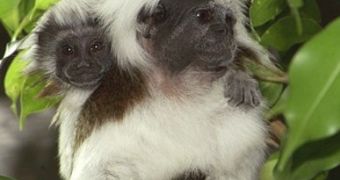This tamarin monkey species is called Saguinus oedipus; but despite its name (from Oedip in the Greek mythology), the sons do not kill their father, nor do they mate with their mothers.
These South American little monkeys, weighing just 450 g (one pound) and being 30 cm (1 ft) long, can live up to 11 years, having a quite 'complicated' sex life. The female is the boss and has two faithful husbands who live in harmony and take care of the young.
The fight of the tamarins is led through ... thrills. These monkeys thrill like songbirds. When two adversaries meet, they emit thrills while advancing towards one another. When they have reached one each other, snout to snout, they change between themselves ... kisses, and stay in this position for 20 minutes, as if they are trying to dominate each other through hypnosis; in the end, one of them gives up and leaves the place. The psychological fight occurred without any physical fight.
These conflicts take place only amongst brothers, never between father and son. The males of the family don't "fight" between them, either. They have to cooperate to take care of the offspring, soon after these are born. As the female usually gives birth to twins, each male will take care of one offspring that usually doesn't weigh more than 40 g at birth.
The cooperation takes place from the very moment they start courting the female. They will mate with her in order, without the slightest conflict or jealousy. This way, each one of the two can 'believe' it has fathered the offspring.
Males and females look alike, and the difference between them (except the genitalia) is a specific scent spread just by the females.
If one family member dies, naturally or preyed, the family disintegrates, the reproduction ceases, and the offspring are abandoned. The family's members try than to form new families, but older individuals usually do not succeed; the young are more likely to do it.
The members of the same group spread a specific scent which impedes related animals to mate, avoiding incest (unlike in happened in Oedip's story). To start its own family, a young male has to find a fellow from another family, about the same age, and when the bond between the two is tight, they begin to be interested in a female, which will join them, turning into the leader of the group.
In the case of a tamarin's relative, the marmosets (Callithrix species), scientists have found "germ line chimerism": some of the sperm or eggs in the individual's gonads carry the DNA of another sibling.
33 % of the two non-identical twins represent chimeras, all tissues, from skin, hair, brain, lung and muscle having cells derived from the other twin. The placentas of the twin fetuses join early in the development provess, and stem cells pass from one to another, before starting their development.
The marmoset can carry the genes of its "uncle", not of its apparent father. In 2007, a chimerism case was found in a pair of American human twins.

 14 DAY TRIAL //
14 DAY TRIAL //